|

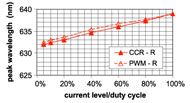
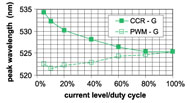
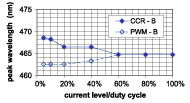
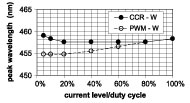
Peak wavelength shift as a function of current level (CCR) or duty cycle (PWM) for red, green, blue and white LEDs for one product manufacturer.
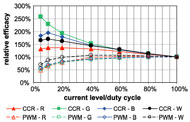
Relative luminous efficacy as a function of current level (CCR) or duty cycle (PWM) for red, green, blue and white LEDs for one product manufacturer.
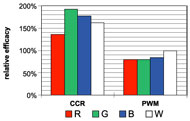
Relative luminous efficacy for red, green, blue and white LEDs at 20% current level (CCR) or duty cycle (PWM) for one product manufacturer.
|
The Effects of Dimming on High-power LEDs (2006)
Dimming control provides not only aesthetic qualities, but is also an important feature in energy conservation efforts with lighting. But dimming can have negative consequences when it lowers the luminous efficacy of the light source or changes its color.
Commercial LED drivers commonly use one of two methods to dim LEDs: continous current reduction (CCR), which decreases the forward current, or pulse-width modulation (PWM), which changes the duty cycle. PWM has been more common for LEDs because of its wide dimming range and linear relationship between light output and duty cycle.
A previous study explored the chromaticity shifts of high-power white LED systems during dimming (See Chromaticity Shifts in High-Power White LED Systems Due to Different Dimming Methods). This follow-up study set out to characterize different types of high-power LEDs and understand how their luminous efficacy and spectrum change under both dimming methods.
EXPERIMENT
The Lighting Research Center tested commercial high-power red, green, blue and phosphor-converted (pc) white LEDs from three LED manufacturers. The spectral and luminous efficacy changes of the LEDs were monitored under both dimming methods at various dimming levels and ambient temperatures.
RESULTS
Spectrum
The InGaN-based blue, green, and pc-white LEDs experienced peak wavelength shifts when dimmed, and these shifts occurred in opposite directions for each dimming method. The wavelengths of these LEDs shifted toward "blue" with increases in current (CCR), as a result of band filling. The LED wavelengths shifted toward "red" with increases in duty cycle (PWM), as a result of added heat at the p-n junction of the LED. Green LEDs always exhibited a greater spectrum shift than the blue LEDs because of their higher indium content.
For red AlInGap LEDs, the peak wavelength shifted toward "red" with increases in current or duty cycle for both types of dimming. This wavelength shift was a result of increased heat at the p-n junction.
Luminous efficacy
At dimmed levels, the luminous efficacy was always higher using the CCR dimming method. Under CCR operation, the LEDs showed a faster rate of input power reduction than the PWM method, meaning that PWM requires more power.
TECHNICAL PAPER
Gu, Y., N. Narendran, T. Dong, and H. Wu. 2006. Spectral and luminous efficacy change of high-power LEDs under different dimming methods. Sixth International Conference on Solid State Lighting, Proceedings of SPIE 6337, 63370J.
Full-text PDF 
RELATED NEWS
LRC Project Sheet 
Delving Deep Into Solid-state Lighting — LRC Newsletter, October 2006
EQUIPMENT SPONSOR
Alliance for Solid-State Illumination Systems and Technologies (ASSIST)
|


